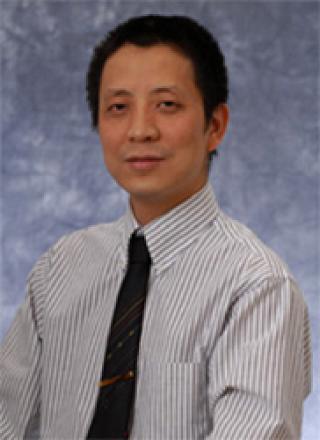
Author: Office of Public Affairs
The National Eye Institute (NEI, part of the National Institutes of Health), for the first time, reached out to the broader scientific community and the general public for bold yet achievable ideas for the next 10 to 12 years. NEI just finished the first phase of the “Audacious Goals challenge." Ten winning ideas were selected from a pool of nearly 500 entries. Dr. Yingbin Fu, assistant professor from Moran Eye Center of University of Utah, is among the 10 winners. Dr. Fu’s audacious idea is to perform “Precise Gene Editing in Vivo”.
Almost every disease has a genetic component. It is also well established that many genetic mutations can lead to diseases such as cancer, Alzheimer’s disease, age-related macular degeneration. Dr. Fu’s idea is to permanently correct disease-associated mutations in a patient using molecules that are specially designed to target mutated DNA sequences and that can be delivered safely and efficiently into the tissue. Such strategy could potentially provide the best cure or prevention for many diseases.
To achieve this audacious goal, two critical elements are required: 1) molecular reagents that are capable of precisely editing mutant genes in vivo with high efficiency; 2) highly efficient and safe methods for delivering such “editing” reagents into the affected tissue. The first element can be fulfilled with the coming development of TALEN (transcription activator-like effector nuclease) technology. TALENs are engineered recombinant proteins, which consist of custom assembled DNA-binding motifs coupled to a DNA cutting enzyme. In a sense, TALEN works like a precision guided “molecular scissor” to target “rogue” DNAs. TALENs can be designed to recognize virtually any DNA sequence in the genome and to generate a targeted double-strand break. To repair the defective gene, scientists also have to deliver a donor DNA that contains the normal gene sequence. In the presence of the “gene break”, human cells can efficiently replace the mutant DNA with the normal DNA provided by the donor DNA. Recent studies showed that this is achievable in animal models and human cells. The second element is also achievable in the next 10 years with rapid progress of both viral and non-viral (e.g. DNA nanoparticles) gene delivery systems. In order to accomplish this goal effectively, traditional eye researchers, molecular biologists in TALEN, scientists in nanotechnology, and experts in viral delivery need to come together, which can be coordinated by NEI for this “audacious” strategic planning and execution.
If this audacious goal is achieved, the impact would be enormous in the prevention and cure of human diseases. As we enter the era of personalized medicine, it will become more and more practical to sequence a person’s genome at low cost. Physicians could perform genetic screens in general population at young ages, and individuals identified with known risk alleles could be treated with TALEN-mediated gene correction before the onset of an eye disease. Of course, in vivo gene editing could also be used to treat patients in the early and intermediate stages of a blinding disease because even rescue of a modest number of photoreceptors may significantly improve a patient’s vision. Such strategy can also be applied to the genetic component of virtually any human disease, whether inherited or resulting from cellular responses to environmental stresses. In vivo gene editing will allow scientists to realize the ultimate goal of the human genome project and personalized medicine.
As for the reason to participate in this competition, Dr. Fu said, “As a citizen of the scientific community, I felt the urgent need and responsibility to help shaping the research direction of NEI and to tackle our nation’s most pressing healthcare challenges.”
Dr. Fu will now travel to Maryland to attend NEI Audacious Goals Development Meeting, which will include about 200 vision researchers, patient advocates, ophthalmologists, and optometrists from the U.S. and abroad. The selected ideas will be discussed intensively for further expansion, development, and refinement. Following the meeting, NEI staff and members of the National Advisory Eye Council will finalize and publish a set of the most compelling audacious goals for the institute and the broader vision research community to pursue over the next decade.
“The selection of the winning entries marks the true starting point for NEI’s Audacious Goals initiative,” said Dr. Fisher. “We are now at the point where some of the world’s most prominent vision experts can discuss these ideas in-depth, establish a set of audacious goals, and weigh in on how we can realize those goals.”
